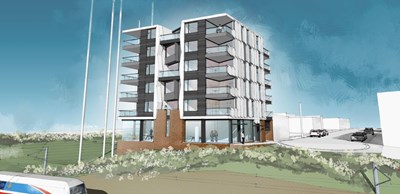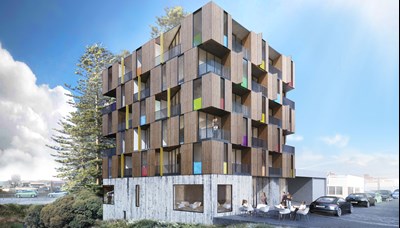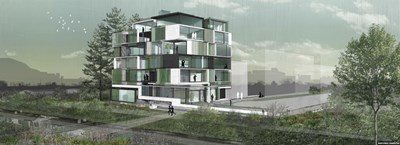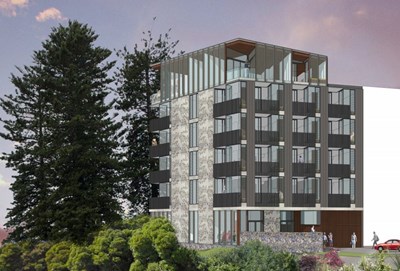Competitive urges – musings on design cometitions
S3 Architects award-winning Akepiro Street Design Competition winning concept.
New Zealand has a poor record in the execution of fairly run architecture competitions, but the Akepiro Street Design Competition aims to change that, says Pip Cheshire.
Competitions are the inevitable collision of hopes and dreams and the cruel realities of a pragmatic world. Like racehorses released from the birdcage we charge off, eyes set on the finish line and throwing all we can at it – clients, practice profitability and family. Such is our thirst for a lick at a project not already tied up by the profession’s behemoths or, more depressingly, the locust-like devastations of project delivery companies, that we do this with only a passing consideration of competition conditions.
This is surprising given the miserable record of competitions in the country. Is there a practice around which has not been burned by a failed competition, hobbled by an impossible brief, supplanted by the second-place getter or had the whole thing collapse amid some impenetrable political schism played out in the newspapers?
The searing pain of Auckland’s Queens Wharf competition [2009] lives on in many of us. That project offered all the possibilities we might hope for – a brilliant architectural scheme breaching the red fence at the water’s edge and reclaiming the wharf for the alienated and disenfranchised citizenry. And didn’t we seize on it? A two-stager, open to all in sundry in the first round to draw out the nutters and deal with consultation, then on to a sudden death five-way sprint. Never mind that the brief was, at best, confused; in we went, with pizzas, beer and midnight oil. Hand it in exhausted to city hall and then … well, then the pollies put the boot in. Who knew so many uptown suits knew so much? Actually, it turned out the question of who knew what was irrelevant as the finalists became a lightning rod for the ongoing Auckland-Wellington slugfest and the project disappeared back into the quagmire of big business lobbying.
The small size of the country and the consequent paucity of opportunities afforded the profession to engage in more complex briefs means that we leap at competitions as an opportunity to prove that, while we might live on an austere weekly diet, our appetite for something a bit meaty is as strong as ever.
The Institute seized on Ockham Residential’s offer to fund the recent competition for housing at Akepiro Street to redress the shortage of opportunities to promote research through design of medium density housing in the context of the special housing areas, and to explore whether the Institute might have a role as a facilitator of competitions involving Auckland Council. In the event the competition unleashed the latent enthusiasm for late nights and pizza, and provoked our profession’s altruistic aspirations to address wider social concerns.
The intensification of land use on the isthmus is a fraught issue unlikely to be resolved soon. Aging baby boomers, spooked at the prospect of high-rise tenements rising next door and undermining the value of their rental properties, have packed community meetings to defuse the Unitary Plan. Architects, the inevitable harbingers of change, are used to the brickbats of disaffected landowners, though it is more usually an irate neighbour who has lost their glimpse of Rangitoto than an entire generation of land-owning Nimbys. However, the prospect of being pilloried by neighbours, irate boomers or city hall didn’t deter more than 60 practices having a thrash at the Akepiro site. This may have had something to do with a fortunate combination of a brownfields site tucked away down a light industrial street, an articulate media savvy developer and the presence of the Council on the judging panel and hence the prospect that, just maybe, the competition would not become a political football.
Not that all was smooth sailing. Councillor Mike Lee, a vociferous critic of the entries in the Queens Wharf competition, declared Akepiro winner Stephen Smith’s apartments “too small”, and the building “ugly and not appropriate”.
This was pretty well expected, but it was something of a surprise to find the competition subject to the digital McCarthyism of ‘Whale Oil’ blogger Cameron Slater attempting to unearth political favouritism. Within the profession, too, the competition provoked some disquiet that highlights the ambiguous view that architects have of themselves. I understand the reservations were founded on the thought that a private developer received three score different concept schemes, five in some detail, for a puny outlay. The feeling was that the unsuccessful schemes would provide valuable source material for future projects, although how this is squared away with our normal emphasis on the importance of site specific design was not clear. The implication is that all work done by an architect should be paid for, though I suspect one might draw a distinction between competitions for public and private projects, the former presumably free of the taint of private gain.
If payment for all work is the professional ideal, I was keen to shape the Akepiro competition in a rather more mercantile fashion – to hook up developer and architect, the former with his own design organisation and uncertain of the need for architects and the latter, hopefully one of many wanting a leg up into this emergent market. It is interesting that a large majority of the entrants were from small and medium sized practices and many from one-person bands. This might reflect a heavy work load in larger practices, reservations about the ability to make a buck out of the project or a boycott of a competition that offered first round entrants only hope, second round competitors a modest payment and the winner a commission.
Whatever the reason, the number and variety of the entries received, and what seems so far to be a well ordered competition with a clear outcome, seems a good result for the winner, the NZIA and the Council. I hope it was also worthwhile for all entrants, that they had an opportunity to stretch out, to research and design for what has to be an increasing typology, and to do so in an arrangement in which their work was assessed fairly and without bias or external influence.
If the process can be counted a success then the general standard of entries indicates we might need a little more practice in this type of building if we are to deliver the promise of medium density housing that offers more than bedrooms shoehorned into unusual forms. Too many of the entrants offered up maze-like planning, often the consequence of a ‘great architectural idea’ eclipsing basic issues of sound planning. There was, too, a rather disappointing lack of experimentation in the configuration of the apartments’ living arrangements, perhaps victim of the developer’s presence at the judging table and a sense that nothing too unusual should be attempted. The balance between the intrusiveness of a too-worked idea and the vacuous absence of design intention is the territory of success and failure. Traversing that within the constraints of city planning controls and the market-focused demands of a commercial client while making a half-pie decent bit of architecture is no mean feat, and the project submitted by S3 Architects’ Stephen Smith achieved this balance well.
We have not had much practice at this sort of building, there being little middle ground between suburban sprawl eating up the city’s fertile perimeter or the crude tenements of the upper CBD. It is imperative that we, as a city and nation, make better, denser housing. To do this requires a range of determinants to align; some of these are in our orbit, and many, such as the financing of land and construction, are not. We might only have an opportunity to effect change in the country’s philosophical approach to funding at the ballot box, but as a profession we need to work harder, think more and offer better exemplars.
Critical to such a discussion is the dissemination of the research – the entries in the competition.
Pip Cheshire is President of the New Zealand Institute of Architects. The Akepiro Street Design Competition was organised by the New Zealand Institute of Architects, Auckland Council and Ockham Residential. A version of this article appeared in the September 2014 issue of Block, published by the Auckland Branch of the New Zealand Institute of Architects.








